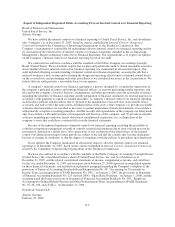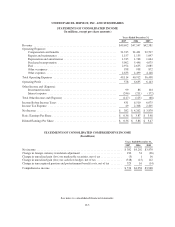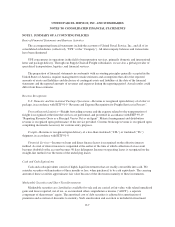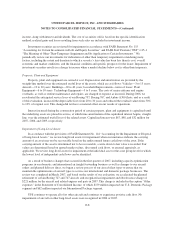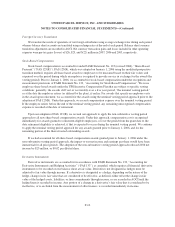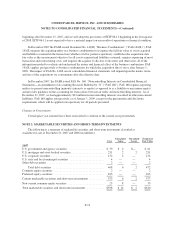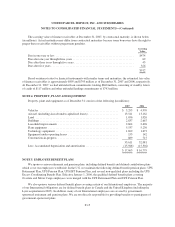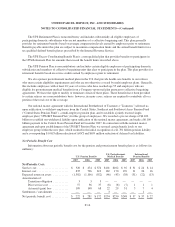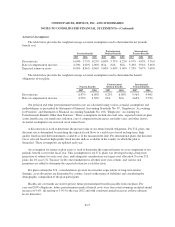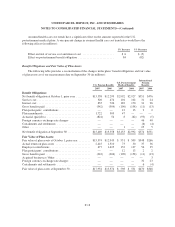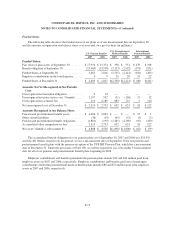UPS 2007 Annual Report Download - page 72
Download and view the complete annual report
Please find page 72 of the 2007 UPS annual report below. You can navigate through the pages in the report by either clicking on the pages listed below, or by using the keyword search tool below to find specific information within the annual report.UNITED PARCEL SERVICE, INC. AND SUBSIDIARIES
NOTES TO CONSOLIDATED FINANCIAL STATEMENTS—(Continued)
Goodwill and Intangible Assets
Costs of purchased businesses in excess of net assets acquired (goodwill), and intangible assets are
accounted for under the provisions of FASB Statement No. 142 “Goodwill and Other Intangible Assets” (“FAS
142”). Under FAS 142, we are required to test all goodwill for impairment at least annually, unless changes in
circumstances indicate an impairment may have occurred sooner. We are required to test goodwill on a
“reporting unit” basis. A reporting unit is the operating segment unless, for businesses within that operating
segment, discrete financial information is prepared and regularly reviewed by management, in which case such a
component business is the reporting unit.
A fair value approach is used to test goodwill for impairment. An impairment charge is recognized for the
amount, if any, by which the carrying amount of goodwill exceeds its fair value. Fair values are established using
discounted cash flows. When available and as appropriate, comparative market multiples were used to
corroborate discounted cash flow results. Our annual impairment tests performed in 2007, 2006, and 2005
resulted in no goodwill impairment.
Finite-lived intangible assets, including trademarks, licenses, patents, customer lists, non-compete
agreements, and franchise rights are amortized on a straight-line basis over the estimated useful lives of the
assets, which range from 2 to 20 years. Capitalized software is amortized over periods ranging from 3 to 5 years.
Self-Insurance Accruals
We self-insure costs associated with workers’ compensation claims, automotive liability, health and welfare,
and general business liabilities, up to certain limits. Insurance reserves are established for estimates of the loss
that we will ultimately incur on reported claims, as well as estimates of claims that have been incurred but not yet
reported. Recorded balances are based on reserve levels, which incorporate historical loss experience and
judgments about the present and expected levels of cost per claim.
Income Taxes
Income taxes are accounted for under FASB Statement No. 109, “Accounting for Income Taxes”
(“FAS 109”). FAS 109 is an asset and liability approach that requires the recognition of deferred tax assets and
liabilities for the expected future tax consequences of events that have been recognized in our financial
statements or tax returns. In estimating future tax consequences, FAS 109 generally considers all expected future
events other than proposed changes in the tax law or rates. Valuation allowances are provided if it is more likely
than not that a deferred tax asset will not be realized.
We recognize liabilities for uncertain tax positions based on a two-step process. The first step is to evaluate
the tax position for recognition by determining if the weight of available evidence indicates that it is more likely
than not that the position will be sustained on audit, including resolution of related appeals or litigation
processes, if any. The second step requires us to estimate and measure the tax benefit as the largest amount that is
more than 50% likely to be realized upon ultimate settlement. It is inherently difficult and subjective to estimate
such amounts, as we have to determine the probability of various possible outcomes. We reevaluate these
uncertain tax positions on a quarterly basis. This evaluation is based on factors including, but not limited to,
changes in facts or circumstances, changes in tax law, effectively settled issues under audit, and new audit
activity. Such a change in recognition or measurement would result in the recognition of a tax benefit or an
additional charge to the tax provision.
F-9





